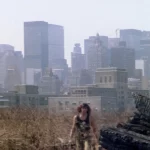Home Video Hovel: John Carpenter’s The Thing, by Tyler Smith
It’s hard to know what to say about John Carpenter’s The Thing that hasn’t been said hundreds (if not thousands) of times by now. Since its release in 1982, it has become a horror staple that has spawned countless imitators, but surprisingly few sequels (beyond an unfortunate prequel/remake released in 2011). Perhaps this is because Carpenter’s film not only features fantastic special effects – which can be borrowed and adapted to other films – but also a sustained tone of dread and paranoia that few filmmakers would be able to adequately mimic. And so, in a genre plagued by franchises, The Thing remains a (mostly) lone wolf of a film, so completely understood to be perfect that it remains largely untouchable.
The story is deceptively simple. A group of scientists in the Antarctic run across an alien organism that has the ability to consume and perfectly replicate other living things. As the organism infiltrates the outpost, paranoia begins to mount, as the scientists become less and less sure about who is human, and who is the Thing. At times, they seem even to doubt whether they themselves are human.
It is this last element that intrigued me the most upon my recent viewing of Scream Factory’s gorgeous new Blu-Ray release. One of the most fascinating elements of the film is its refusal to give us more information than we should have. There are a lot of questions left unanswered, letting us know only enough to be terrified. But questions about the Thing’s life cycle and exactly how completely it mimics other organisms – perhaps to the degree that some of their actual consciousness remains intact – remain a disquieting mystery. Often, the actors themselves were unsure of exactly what they were in a given scene, and Carpenter refused to put their minds at ease.
Carpenter’s embracing of the unknown seems at odds with a film as graphic as The Thing. Where other great horror films – such as Jaws or Alien – seem to understand the benefit of hiding their monsters for as long as possible, Carpenter is willing to put it all out there, knowing that the creatures that then-23-year-old makeup artist Rob Bottin crafted could actually trump whatever the audience has imagined. So why would the director refuse to give the audience more factual information about the monster and how it operates?
Because Carpenter understands that the true horror of The Thing isn’t actually in the understanding of the monster, but the suspicion that is engendered when we encounter it. By 1982, we’d already seen plenty of horror movies in which the protagonists are holed up together, slowly but surely cracking under the pressure of what’s outside. But, the danger is always outside. What The Thing does is bring the danger inside, disguised so effectively that it could in fact be standing right next to our main character and nobody would know until it’s too late. And the more graphic the special effects are when it comes time to show the monster, the more horrifying the idea that it could be in the room with us, waiting patiently to reveal itself.
A horror premise like this requires actors that are able to convey a level of stress that most horror movies – or dramas, for that matter – don’t require. And the cast of character actors capture the mounting fear and paranoia effectively. But perhaps the most notable performance is that of Wilford Brimley. It’s strange to us in 2016 that Brimley – whose pop culture legacy seems to begin with Quaker Oats and ends with “diabeetus” – could be such a dependable actor, but his appearances in other films of the time – such as The China Syndrome, Absence of Malice, and Cocoon – are always welcome. He is a remarkably forceful on-screen presence, displaying a combination of no-nonsense authority and down-home charm. His word is often the official line that the other characters have to abide by. So when his character in The Thing – whose quiet investigation of how the organism operates is systematic and reasonable – starts to act impulsively and dangerously, it tells the audience that there is something extremely scary happening here. Because while it’s entirely possible that Brimley’s formerly logical character could just be losing his mind, there is also the suggestion that, given the situation, losing one’s mind is the only logical thing a person can do.
This is what makes The Thing such an effective horror movie. In the midst of all the special effects, it is ultimately about the psychological impact of a high stress situation. Paranoia, insomnia, aggression; these are the baseline states for any character that encounters the Thing, and it’s unavoidable. As the scientists investigate another camp – ravaged by the Thing – we see the aftermath of a bizarre conflict; one that ended in murder, suicide, and seeming irrationality. But we are, in fact, looking at a preview of what’s to come for our heroes. And, soon enough, our characters fall into the same inevitable pattern, killing each other and themselves.
Because, with The Thing, John Carpenter seems to be suggesting that there is a cyclical predictability to human suspicion. Appropriately, the film was released during the later years of the Cold War, which had long been associated with spies and intrigue; two things that can be thrilling, but eventually lead to patterns of destruction and moral compromise. But these themes can be universal, as the world is currently in the midst of a debate about taking in foreign refugees. Some argue that hidden within the ranks of these poor souls are dangerous terrorists, while others say that humanitarianism must win the day, despite the possible danger. In a way, both sides are correct, but the debate would be far easier if terrorists wore uniforms so that we could simply weed them out. But they look just like the other refugees, the vast majority of whom are decent people just looking for sanctuary. How do we know who’s human, and how do we know who’s a monster? This is the question at the core of The Thing, and it’s one that has been asked, and will continue to be asked, throughout human history, with often horrific results.





























I think one major reason it didn’t get a sequel (until the recent unfortunate quasi-remake) is that it wasn’t very commercially successful on initial release. Blade Runner didn’t get one either (although Denis Villenueve is working on one now).
That’s a good point. And while the film was considered a success (at least culturally) by the 1990s, I’m sure executives didn’t see much need for a sequel so many years after the original. But, of course, by the late 2000s, when any known property was ripe for a sequel, prequel, or reboot, suddenly a follow-up to THE THING sounded like a great idea.
Incidentally, I just re-watched the 2011 film and, no, it was not a great idea.
You know, something that you wrote struck a chord with me. Carpenter’s earlier films, like “Assault on Precinct 13”, “Halloween”, and “The Fog” focus on attacks from without. “Assault on Precinct 13” and “The Fog” being literally “Siege Movies” in the same vein as “The Alamo” and “Zulu”.
With “The Thing” and extending into “Christine”, Carpenter brings the attack from an external force to an internal one. Those we once trusted are no longer reliable sources of safety and protection.
Finally, you have “Prince of Darkness”, “They Live”, and “In the Mouth of Madness”, where the “heroes” are beset on all sides, both without and within by horrors and dangers.
Now, I’m surely overgeneralizing here and each of these films have nuances and story elements beyond the descriptions I’ve provided but it does seem to fit a logical (and chronological) progression and intensification of horror elements (or avenues of attack) within Carpenter’s filmography.